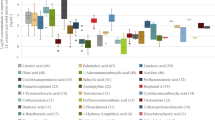Abstract
In this study, a method for the determination of organic micro-pollutants, i.e. personal care products such as synthetic musk fragrances, household bactericides, organophosphate flame retardants and plasticizers, as well as phthalates in sludge, has been developed. This method is based on lyophilisation and accelerated solvent extraction followed by clean-up steps, i.e. solid phase extraction and size exclusion chromatography. The determination is performed by gas chromatography coupled to mass spectrometry. Stable isotope-labelled compounds such as musk xylene (MX D15), tri-n-butylphosphate (TnBP D27) and triphenylphosphate (TPP D15) were used as internal standards. Recovery rates were determined to be 36–114% (with typical relative standard deviation of 5% to 23%) for the target compounds. The limit of detection was 3–30 ng g−1, and the limit of quantification was 10–100 ng g−1 dry matter.




Similar content being viewed by others
References
Riley CE (2001) Waste Manage 21:465–470
Sánchez-Brunete C, Miguel E, Tadeo JL (2007) J Chromatogr A 1148:219–227
Pawelczyk A (2005) ISAH. Warsaw, Poland
Vogel I, Bannick CG, Böken H (2004) Soil and compost eco-biology. León, Spain
Peck AM, Hornbuckle KC (2004) Environ Sci Technol 38:367–372
Peck AM, Linebaugh EK, Hornbuckle KC (2006) Environ Sci Technol 40:5629–5635
Garicano EA, Borkent I, Hermens JM, Vaes WJ (2003) Environ Sci Technol 37:3111–3116
Bester K (2004) Chemosphere 57:863–870
Bester K (2005) J Environ Monit 7:43–51
Herren D, Berset JD (2000) Chemosphere 40:565–574
Berset JD, Bigler P, Herren D (2000) Anal Chem 72:2124–2131
Kupper T, Berset JD, Etter-Holzer R, Furrer R, Tarradellas J (2004) Chemosphere 54:1111–1120
Peck AM (2006) Anal Bioanal Chem 386:907–939
Chen X, Pauly U, Rehfus S, Bester K (2009) Chemosphere 76:1094–1101
Bester K (2009) J Chromatogr A 1216:470–480
Singer H, Müller S, Tixier C, Pillonel L (2002) Environ Sci Technol 36:4998–5004
Lopez-Avila V, Hites RA (1980) Environ Sci Technol 14:1382–1390
Paxeus N (1996) Water Res 30:1115–1122
Lindström A, Buerge IJ, Poiger T, Bergqvist PA, Mller MD, Buser HR (2002) Environ Sci Technol 36:2322–2329
Bester K (2003) Water Res 37:3891–3896
Bester K (2005) Arch Environ Contam Toxicol 49:9–17
Orvos DR, Versteeg DJ, Inauen J, Capdevielle M, Rothenstein A (2002) Environ Toxicol Chem 21:1338–1349
Coogan MA, Edziyie RE, La Point TW, Venables BJ (2007) Chemosphere 67:1911–1918
DeLorenzo ME, Keller JM, Arthur CD, Finnegan MC, Harper HE, Winder VL, Zdankiewicz DL (2007) Environ Toxicol 23:224–232
IAL Consultants (1999) IAL market report. The European Flame Retardant Chemical Industry 1998. IAL Consultants, London
Fries E, Puttmann W (2001) J Environ Monit 3:621–626
Meyer J, Bester K (2004) J Environ Monit 6:599–605
Sanchez C, Ericsson M, Carlsson H, Colmsjo A (2003) J Chromatogr A 993:103–110
García M, Rodríguez I, Cela R (2007) Anal Chim Acta 590:17–25
Bester K (2005) J Environ Monit 7:509–513
You J, Lydy MJ (2004) Arch Environ Contam Toxicol 47:148–153
Roh JY, Jung IH, Lee JY, Choi JH (2007) Toxicology 237:126–133
Fromme H, Kuchler T, Otto T, Pilz K, Muller J, Wenzel A (2002) Water Res 36:1429–1438
Sablayrolles C, Montréjaud-Vignoles M, Benanou D, Patria L, Treilhou M (2005) J Chromatogr A 1072:233–242
Aparicio I, Santos JL, Alonso E (2007) Anal Chim Acta 584:455–461
Andresen J, Bester K (2006) Water Res 40:621–629
Bester K, Hühnerfuss H (1997) Fresenius’ J Anal Chem 358:630–634
Richter BE, Jones BA, Ezzell JL, Porter NL, Avdalovic N, Pohl C (1996) Anal Chem 68:1033–1039
Vandenburg HJ, Clifford AA, Bartle KD, Zhu SA, Carroll J, Newton LD, Garden LM (1998) Anal Chem 70:1943–1948
Gatermarm R, Hühnerfuss H, Rimkus G, Attar A, Kettrup A (1998) Chemosphere 36:2535–2547
Käfferlein HU, Göen T, Angerer J (1998) Crit Rev Toxicol 28:431–476
Hicken EJ, Corey EJ (2008) Org Lett 10:1135–1138
Acknowledgements
The authors acknowledge the support of the Environmental Protection Agency of Northrhine Westphalia through the project “BASPIK”, of the Ministry for Economics through the ProInno/AIF project “Abbau von organischen Schadstoffen im Rahmen der Klärschlammvererdung” and xenobiotic groups of University of Duisburg-Essen as well as the skilled technical laboratory help of Jennifer Hardes for cooperation. Additionally the authors are indebted to the co-operating waste water treatment plant for the possibility to sample their sludge for method development. The authors also acknowledge the support from the project “In situ characterization of microbial degraders of triclosan and methyl-triclosan from wastewater treatment plants” from the Danish research council FTP.
Author information
Authors and Affiliations
Corresponding author
Electronic supplementary materials
Below is the link to the electronic supplementary material.
ESM
(PDF 59 kb)
Rights and permissions
About this article
Cite this article
Chen, X., Bester, K. Determination of organic micro-pollutants such as personal care products, plasticizers and flame retardants in sludge. Anal Bioanal Chem 395, 1877–1884 (2009). https://doi.org/10.1007/s00216-009-3138-5
Received:
Accepted:
Published:
Issue Date:
DOI: https://doi.org/10.1007/s00216-009-3138-5




